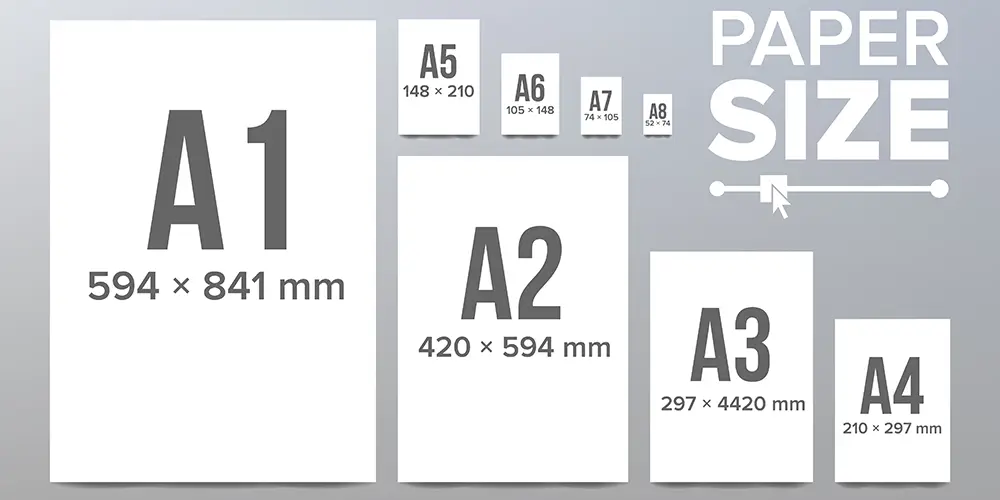a4 paper is a standard paper size widely used around the world, especially in Europe, Asia, and Africa. It is the most common paper size for documents, letters, and other printed materials. The A4 paper dimension is defined by the International Organization for Standardization (ISO) as 210 x 297 millimeters (mm). In centimeters (cm), the A4 paper dimension is:
- Width: 21 cm
- Height: 29.7 cm
What is the Standard Size of A4 Paper?
The A4 paper size is part of the A series of paper sizes, which includes A0, A1, A2, A3, A5, A6, A7, and A8. The dimensions of each size in the A series are based on an aspect ratio of the square root of 2, meaning that a sheet of paper can be folded in half and still maintain the same proportions.
A4 paper is widely used for printing documents, reports, resumes, and letters due to its convenient size and readability. The standard size of A4 paper makes it compatible with most printers and office equipment, ensuring that documents can be easily printed and circulated.
Advantages of Using A4 Paper
- Standardization: A4 paper size is standardized across the globe, making it easy to use with various devices and applications.
- Efficiency: A4 paper is easy to handle, store, and transport, making it a practical choice for everyday use.
- Legibility: The ample space provided by A4 paper allows for clear and easy-to-read text, whether printed or handwritten.
A4 Paper Dimensions in Centimeters

The A4 paper dimension in centimeters is crucial for ensuring that documents are formatted correctly and printed accurately. The width of A4 paper is 21 cm, while the height is 29.7 cm. These precise measurements enable printers and copiers to reproduce images and text consistently on A4 paper.
A4 Paper Dimension in Centimeters Table
| Measurement | Value (cm) |
|---|---|
| Width | 21 |
| Height | 29.7 |
History and Development of A4 Paper

The A4 paper size was first introduced in the early 20th century as part of the German Industrial Standard DIN 476. This standard was adopted by the International Organization for Standardization (ISO) in 1975 and has since become the most widely used paper size worldwide. The development of the A4 paper size was driven by the need for a standardized format that could be easily produced and reproduced.
Evolution of A4 Paper Standard
- German Industrial Standard (DIN 476): The A4 paper size was initially established as part of the DIN 476 standard in Germany.
- International Standardization (ISO): The ISO adopted the A4 paper size in 1975, recognizing its widespread adoption and practicality.
- Global Acceptance: Today, A4 paper is used in offices, schools, and homes around the world, demonstrating its universal appeal and utility.
Benefits of Using A4 Paper
A4 paper offers several advantages over other paper sizes, including:
- Standardization: A4 is a standard size, which ensures compatibility with a wide range of printers, copiers, and other office equipment.
- Efficiency: A4 paper is a convenient size for handling and storing. It can be easily folded, stacked, and filed.
- Legibility: The a4 size provides ample space for text, making it easy to read and suitable for both printing and handwriting.
Applications of A4 Paper
The versatility and ubiquity of A4 paper make it suitable for a wide range of applications, including:
- Business Documents: A4 paper is commonly used for printing reports, memos, invoices, and business correspondence.
- Educational Materials: Schools, colleges, and universities often use A4 paper for printing assignments, handouts, and study materials.
- Personal Use: A4 paper is ideal for printing resumes, cover letters, invitations, and other personal documents.
Variations of A4 Paper Sizes
While the standard A4 paper size is 210 x 297 mm, there are variations and related sizes within the A series of paper sizes. Some common variations of A4 paper include:
- A5: Half the size of A4 (148 x 210 mm)
- A3: Twice the size of A4 (297 x 420 mm)
- A6: Half the size of A5 (105 x 148 mm)
Understanding these variations can help users choose the right paper size for their specific needs.
A4 Paper Size Comparison List
- A3: 297 x 420 mm
- A4: 210 x 297 mm
- A5: 148 x 210 mm
- A6: 105 x 148 mm
How to Convert A4 Paper to Other Sizes
Converting A4 paper to other sizes can be done using simple folding techniques or printing settings. Here are some common methods for converting A4 paper to different sizes:
- Scaling: Adjust the print settings on your printer to resize a4 documents to A3, A5, or other paper sizes.
- Trimming: Use a paper cutter or scissors to trim A4 paper to smaller sizes like A5 or A6.
- Folding: Fold A4 paper in half to create two A5 sheets, or in quarters to create four A6 sheets.
Tips for Using A4 Paper Effectively
To make the most of A4 paper for your printing and document needs, consider the following tips:
- Orientation: Choose between portrait or landscape orientation based on the content and layout of your document.
- Margins: Leave sufficient margins around the edges of the page to prevent text or images from being cut off during printing.
- Quality: Use high-quality A4 paper for important documents to ensure durability and professional appearance.
Controversies and Criticisms Surrounding A4 Paper
Despite its widespread use, A4 paper has faced some controversies and criticisms over the years. Some of the key issues include:
- Environmental Impact: The production and disposal of paper, including A4 size, contribute to deforestation and waste.
- Digital Alternatives: In an increasingly digital world, some question the need for physical paper, including A4 size, in favor of electronic documents.
- Ergonomics: Prolonged use of A4 paper in office settings has been linked to ergonomic issues such as eye strain and repetitive motion injuries.
These concerns have prompted discussions about the sustainability and relevance of A4 paper in the modern age.
Future of A4 Paper
As technology continues to advance and digital alternatives become more prevalent, the future of A4 paper remains uncertain. However, the enduring popularity and practicality of A4 paper suggest that it will continue to be used for various purposes in the years to come.
Potential Trends in A4 Paper Usage
- Green Initiatives: Increased focus on sustainability may drive the development of eco-friendly A4 paper options.
- Digital Integration: A4 paper may be used in conjunction with digital platforms for a seamless transition between physical and electronic documents.
- Customization: Personalized A4 paper designs and finishes could cater to niche markets and creative industries.
Conclusion
In conclusion, the A4 paper dimension in centimeters is a fundamental aspect of document design and printing. Understanding the standard size of A4 paper, its history, benefits, and applications is essential for professionals and individuals who rely on this ubiquitous paper size. While controversies and criticisms surround A4 paper, its adaptability and widespread use indicate that it will remain a staple in offices, schools, and households for the foreseeable future. Whether for business, education, or personal use, A4 paper continues to play a vital role in our daily lives.